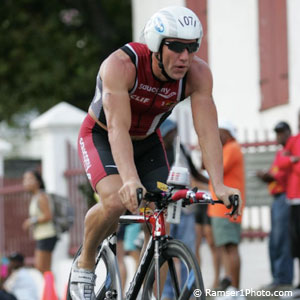Belinda Granger speaks!
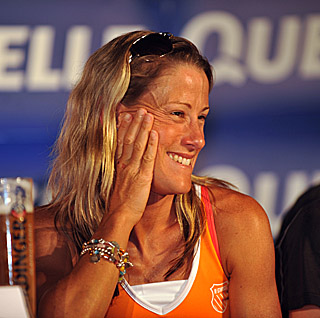
Belinda Granger is gutsy. Thirty three straight Ironman-distance finishes without a dropout, no matter what. Want more proof? She got hit by a car days before Quelle Challenge Roth and fought through the pain with a splint and a smile to finish 5th. Still skeptical? She put off surgery to repair a thickening wall in her crucial iliac artery to win and set a course record at Ironman Malaysia.
She is also very talented. At the age of 37 last year, she rode to a 4:48:08 bike split that was seconds behind the world best mark. She podiumed at almost every Ironman race she entered (except Hawaii) for a seven years. And this year, three months after her surgery, she won Honu 70.3, outdueling 2006 Ironman 70.3 World Champion Sam McGlone.
But for aficionados of accomplished triathletes who can talk, the woman who incorporates the term ‘Megamouth’ into all her digital communications is in a class by herself. Belinda Granger spoke to Slowtwitch a few days before heading out from Boulder to defend her Ironman Canada crown.
ST: People talk a lot about health care reform here in the USA. What did your iliac artery operation and after care cost you in Australia?
Belinda Granger: I waited until I returned to Australia , where our medical system is both high in quality and much more affordable. We pay $550 for a professional triathlon license in Australia. People say oh that’s terrible. But that pays for insurance. If I have some emergency care to do in the USA, I might well pay $5,000 for some treatment, and my insurance from Triathlon Australia reimburses out of pocket costs. Justin and I also pay roughly $140 a month for our own private medical insurance. When I had my iliac artery operation and a five day private hospital stay, I ended up paying maybe $1,500 and my private health insurance paid the rest. Hilary Biscay went to the dentist during her stay in Noosa this summer and paid very little. She also took a visit to my GP and said it was a lot less than what she would have paid at home. It actually scares me to think about having to visit the hospital or a doctor here – I have heard so many different stories about the costs involved. It makes me realize how good we have it at home.

ST: It must have been tough on you to take three months off training?
Belinda: My doctor gave me a thorough explanation and after that, it wasn't hard at all. I love triathlon and missed it. But I love my life more. I was told that a professional cyclist came back too soon from the same operation and died as a result of internal bleeding. The problem was not the repaired artery but the fact that my stomach wall needed time to heal, otherwise chances of internal bleeding and hernia would result. He then explained to me the complications that could arise from a hernia – not pretty. I also had to make sure that the scar left from the removal of the vein from my lower leg was properly healed and that other veins had taken on the role of that missing vein.
ST: How were you able to race Malaysia before the operation and win the race in record time when you had the condition which restricted blood flow to one leg by 25 percent of capacity? As you explained, you started experiencing weakness in the leg at Ironman Hawaii last October when you faded from contention to 17th.
Belinda: Malaysia I did on sheer guts and determination. I knew I only had 25% blood flow to my right leg but to tell the truth I was so used to riding with my right leg feeling terrible that I had almost forgotten how it felt when it was healthy. I pushed the bike hard and just did what I needed to do to hold onto the lead during the run – it certainly was not a pretty run. I am proud I was able to set a PR of 4:48:08 on the bike and so I had 28 minutes in hand on Nicole Leder so I could run a conservative 3:36:10 and still win by 15 minutes — and set a course record of 9:21:10.
ST: Three months after your operation, it was nice you won Honu. How did you get back so fast?
Belinda: I did and I didn't. To me it seemed like an eternity before I was back in to full training. I was able to swim first but no tumble turns. Then I was allowed back on the bike – but only on the trainer. But it took me even longer to get back to running because of the impact. I was happy to win Honu, but I thought I might be able to back it up and race the Rev 3 Half in Connecticut the next weekend. I had a terrible race and was so disappointed. I just didn't have the base fitness or strength needed to race back to back. It has taken me a long time to get it back. And my husband Justin helped me find the patience I needed – not one of my strong points.
ST: It didn’t help that you got hit by a car just before Quelle Challenge Roth in Germany.
Belinda: No, but I promised myself after dropping out of my first ever Ironman Australia I would never DNF another and I didn’t. I finished 5th. Ultimately, I feel lucky that I can still practice the sport that I love.
ST: How does the iliac surgery feel now?
Belinda: I am not sore at all. I am fine. But I am still not 100% back. I do not think I gave the surgery enough credit. As athletes we often think we are invincible. Now after spending a good chunk of the summer in the Swiss Alps and here in Colorado, I feel like I am almost at my previous fitness. I still lack little bit of strength but another two months and I’ll definitely be back. Usually by the time I get to Kona I have raced myself into the ground so maybe having this forced rest will be a good thing come Hawaii.
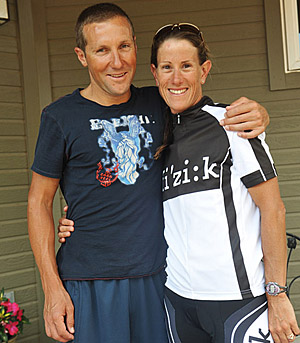
THE BEGINNING
ST: From whom in your family did you get your love of sport?
Belinda: Both of my parents love sport and love being active. As a kid, I did gymnastics, athletics, swimming, water polo, touch football, netball — everything. Unlike my sister Danielle who is two years younger, she is more a 'social' athlete and enjoys parties more than sporting events. My mum was a swimmer and a diver. My dad was into rugby union and running.
ST: What was your first memory of sport?
Belinda: My introduction into sport came when I did my first fun run with my dad – an 8k at the age of six. I remember to this day lining up in the middle of hundreds of people. Just before we started, my dad turned to me and said “Now Belinda, many of these people will take off very quickly. Ignore them and run very slowly at first. This is a long race and if you start easy you will pass many of them by the end.” I said “OK Dad. I will take it easy and work into it.” Could you imagine? I took off like mad. So dad ends up dragging me home the last few kilometers. But I had so much fun! I loved it.
ST: What was your best sport?
Belinda: During my school years I was right into gymnastics. I loved it and would spend pretty much every day upside down. I worked my way up to Level 7. (You need Level 10 to be Olympian)
ST: What was your first triathlon?
Belinda: I did my first triathlon in 1991 when I was at the University of Sydney. It was in-between a sprint and an Olympic distance. I did well, had fun but didn’t do another until 6 months later.
ST: What was your degree?
Belinda: I got a degree called Bachelor of Human Movement. It is basically a degree in Physical Education. When I graduated, I taught physical education for ten years. In fact, I even taught Brett Sutton’s kids. I’ve known him a long time. It is pretty cool to see his 'kids' now – they are all grown up and are such lovely adults.
ST: What is your family up to now?
Belinda: My dad Neville is competitive like me. He gives me the race report days before. He knows all the facts and figures of all my competitors – how they did in their last race, what their splits are, their strengths and weaknesses. It is so funny – he knows more about my competition than me. But his advice to me before a big race is always the same: 'Get out front and stay there'. And that’s what I do. It is how I approach all of my races – I love to race from the front. My mum Carol is 66 and she still teaches full time. She would go crazy if she couldn't use her mind. My dad is a retired engineer and he loves his free time. He keeps himself busy by taking care of their property.
They have watched me race many times – Australia, Hawaii, Germany but they have never seen me race in mainland USA. But they have been traveling around the American West hiking and sightseeing this summer and they will be there in Canada – it will be their first time to Canada.
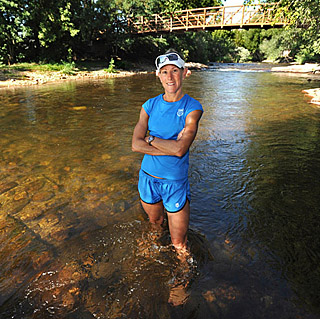
ST: How did your Ironman career start?
Belinda: My first was Ironman Australia in 1999. My tire punctured and it took me 20 minutes to change. It was a cold day and I went hard to make up the time and basically blew myself up. I withdrew 18km intro the run, and I vowed I’d never drop out again. So far I have kept that vow through 33 Ironman races.
ST: How did you meet your husband Justin?
Belinda: I met Justin in 1993 when we were both 'Bondi Brats' – that’s the Bondi Running and Triathlon club. I did Ironman Australia in April of 1999 and did not finish. We were married by November that same year.
He has been in the sport for a long time – he used to race Greg Bennett back when he was a junior and does well getting top tens at Ironman. He has taught me more than anyone when it comes to Ironman – the most important being patience.
ST: You did triathlon for ten years and worked as a full time teacher before turning pro. Why did you wait and what was the turning point?
Belinda: My first time at Ironman Hawaii in 2002 I got 15th. That was the year that Kate Major beat me and got first amateur and took 11th overall at Hawaii. I am very competitive and I felt I was not a professional until I got top 10. So for the time being I worked full time teaching and Justin worked for a bike distributor in Australia. I liked the security of having a job and not relying on triathlon to make ends meat. But the more racing I did overseas, the more I wanted to become true professional. I absolutely loved the lifestyle and I loved the sport. I started taking more and more time off work and it then got to the point where I was spending more time away from work and more time traveling the world. Justin and I finally made the decision that I would resign from my job as a teacher and give my sport a real go. Justin said he would stay working full time to support my dream.
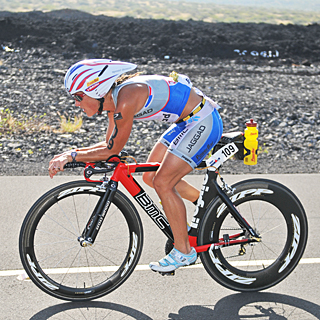
BRETT SUTTON
ST: When did you sign on with Brett Sutton?
Belinda: Three years ago. I started mid 2006 and went through to the end of 2008.
ST: How many Ironman had you won before?
Belinda: I'd won three Ironman Koreas (2001-2-3) and Quelle Challenge Roth in 2005. I also podiumed at almost every race I entered. In 2006 I won Ironman Canada for my first race under Brett. In 2007 I won Ironman Lake Placid and Challenge Wanaka. And I won Ironman Malaysia, Ironman China and Ironman Canada in 2008.
ST: How did working with Brett’s squad work?
Belinda: First and foremost, they are a great bunch of people. My three years with Brett and the squad were amongst the most enjoyable and rewarding I have had during my career. The friendships forged and support given was amazing. We pushed each other a lot but not every day. Brett is so intuitive and knows when to push us and when to let us go it alone. Many days I would train by myself, and other days train with the boys and with some of the girls. That is what I loved the most – you never knew what the day was going to hold. The thing that he is so good at, that makes him better than any coach in the world, is his ability to find out what makes a person tick and knowing when to push you and when to back off. He teams each athlete up with the right person to get the best results.
ST: Your favorite Sutton training camp — Thailand, Philippines or Switzerland?
Belinda: My favorite place to train was Leysin, Switzerland. I love training in the mountains. It is just so beautiful and the training is so hard and honest – no hiding. You don’t get anything for free. We worked hard every training session. The little town of Leysin is a great community and they have embraced us as elite athletes. It is a lovely atmosphere up there.
ST: What did Brett do most for you?
Belinda: I think he fine tuned me. He really opened up the idea of racing outside my comfort zone. Part of that was making me live without my creature comforts and going to places in isolation where you were there simply to train and nothing else. Mind you, Brett still called me 'the five-star Freddy' of the squad.
ST: What did he do for your confidence?
Belinda: Brett made me confident in my strengths. When I went to Ironman Canada for the first time in 2006, he told me “You can win this race. The course is built for you.” He was not being arrogant, he just had such belief in me and in turn you could not help but have belief in yourself. It was not arrogance, he just has such total faith in his athletes and how hard we have trained. What I love best about him is his honesty. He is a straight – shooter. He will never give you a compliment if it is not deserved but he always rewards honest, hard work.
ST: Outside perception was that you and Hilary Biscay and Chrissie Wellington had a big break up with Sutton at the end of last year.
Belinda: Everybody thought it was a big bust up. But we were told from the start when we first joined the squad that Brett’s biggest dream was to start a pro triathlon team similar to pro cycling with common sponsors and support. Team TBB was formed and we knew that as soon as some big sponsors came on board we would have to choose. At the end of 2008 we were told that the team would begin at the beginning of the 2009 season. But athletes like me who were already established, elite athletes when we joined had sponsor relationships that went back many years. I weighed the pros and cons and finally I was not willing to give up my sponsors who were my main financial support. I’d also just signed a great new deal with K-Swiss, who had just started developing running shoes and I was excited to be with a company that was new to the market and had some great ideas.
ST: If things changed, would you go back to Brett as a coach again?
Belinda: That is a very interesting question and probably totally irrelevant as it is what it is. Brett and I are still great friends and always will be. I have known him for a long time. After Roth this year I went back and stayed a few days with Bek Keat in Leysin. It was great seeing him and meeting the new team – they are a great bunch.
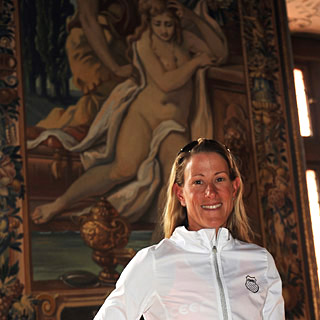
LOOKING TO THE FUTURE
ST: Were you disappointed to break 9 hours last year at Quelle Challenge Roth and come 4th?
Belinda: I was not disappointed – I gave it my all on the day and you can’t have real regrets if you do that. I have a checklist of things to do in this sport before I retire – one of those being to crack the 9 hour mark. No matter what place I got in the race, I can finally put on my resume that I cracked 9 hours.
ST: What else is on that list?
Belinda: I wanted to win an Ironman and I ticked it off early. (Korea 2001) Now I have only a few more boxes left to tick off. Next I want to get top five in Hawaii – I have been 6th 7th 8th 9th and 10th but I have never been able to crack the top five.
ST: Brett Sutton said that you would have done much better at Kona if they changed the start waves to keep the pro women away from the faster age group men. Do you agree?
Belinda: The trouble with Hawaii is that age group men and pro women get caught up with each other. It is a World Championship – I believe that the pro men, pro women and age groupers should all have separate starts. I think they should start the pro men first, then the pro women two minutes later, then the age groupers 30 minutes after that. This would make for a much fairer race for all.
So outside of Hawaii, I pick courses better suited for me like Ironman Lake Placid and Ironman Canada. Both of those have demanding hills that break up packs and demand that you have to ride the full 180km on your own. On a course like that, weaker cyclists are worn down and cannot run nearly as fast as they can when they do not have to ride so hard for the entire 180k.
ST: What are your thoughts on retiring?
Belinda: For now, Justin and I are living our dream. So retiring will be almost as if I give up my life. It’s not just about racing. I will never ever give up triathlon completely. It will always be a part of Justin’s and my life. I take each year as it comes so as long as I am still enjoying the racing, then I will continue to race. I am still continuing to improve and I still genuinely enjoy the sport and all that it entails so for now – retirement is not on the cards.
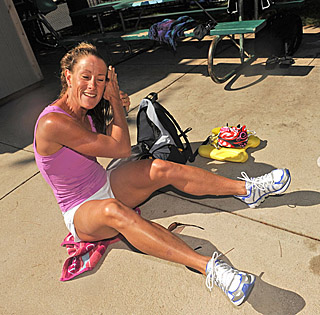
ST: On your own, you seem to have chosen a base that is America’s answer to Leysin – Boulder. What drew you here?
Belinda: I have absolutely loved my time here in Boulder and I have the most amazing group of athletes to train with. But the best thing is that they are not just training buddies but true friends and we love going out for dinner and hanging out after training- it has been a really great summer.
ST: Who do you look up to in the sport?
Belinda: My first hero was Welchy. He is so talented, so funny, so approachable and so modest. And when he hit it big he did not change. He stayed the same fun-loving guy he always was. Heather Fuhr is one woman I look up to as an ideal. Not only does she have a ridiculous number of Ironman wins (15) and is an amazing athlete, she genuinely loves the sport and continues to play a very important role in the sport today.
ST: You are thinking of retiring from elite competition say at age 40. But Natascha Badmann is pushing the age barrier out of the picture. I think she might have considered retirement if not for that accident, but she worked hard to finish up on her own terms. She is a still competing at the highest level at age 43 and 44.
Belinda: Girls like Natascha and Chrissie are so ridiculously talented. Age is not a barrier for any of us – only if we let it be. Natascha is still riding like a champion. She is an amazing athlete. At the Rev 3 race this year Natascha led for most of the day and only surrendered halfway through the run to Mirinda Carfrae, a woman 15 years younger. Natascha showed us all at that race that she still has it.
ST: How does the Ironman Canada women’s field look?
Belinda: The women’s field is stronger and deeper than the previous two years that I have done it. I think my biggest rival will be Teresa Macel. She is now coached by Brett Sutton and has improved so much. She just won Ironman Lake Placid and swims and bikes phenomenally. But I am just looking forward to racing there again for the third time – it is the greatest Ironman course in the world.
ST: So who will win Kona?
Belinda: Chrissie will win again this year. But what you will see this year is what Chrissie has done for the sport. Now there are 10 women who believe they can win and they all fight without fear. The women’s field now has stepped it up two or three levels. They do not race for second. Girls like Rinnie, Natasha, Sandra Wallenhorst, Yvonne Van Vlerken, Bek Keat and Catriona Morrison, to name a few, are there to try to win – they are not there just to race for second place. They are going to give it their best shot and are not scared to lay it on the line and do all they can to win.
ST: One last question. Looking at photos of you winning races, it is clear you have perhaps the best abs in the sport. Did you suffer some when the doctors had to cut through them in your iliac artery surgery?
Belinda: I will be honest. I did have some pangs of vanity after the operation. I had great abs and they had to cut a little on the legs and my lower abdomen. But Justin and everyone told me I should treat it like badge of honor. And now I do.


